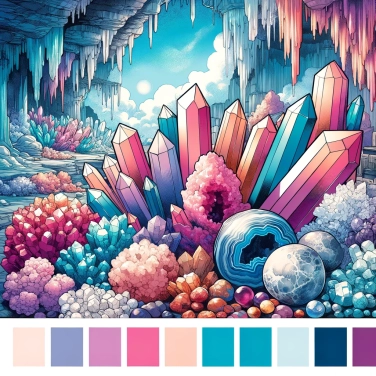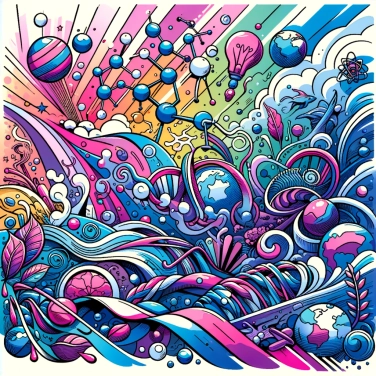The bright colors of minerals are generally due to the presence of chemical elements or impurities in their crystalline structure, which absorb and reflect light in a specific way, thereby giving various colors.

The bright colors of minerals mainly come from the chemical elements they contain. For example, the presence of metals like iron, copper, chromium, or manganese plays a significant role. These elements have electrons capable of absorbing certain colors from the light spectrum and reflecting others, thus giving a specific color to the mineral. Sometimes, a tiny change in the chemical composition is enough to completely alter the color: a few traces of chromium make emeralds green, while the same element, in another mineral, can tint it bright red or vivid yellow. It all comes down to atoms, their electrons, and their organization.
The color of minerals mainly depends on how they interact with light. When white light strikes a mineral, certain wavelengths (certain "types of color") are absorbed, while others are reflected or transmitted. For example, if a mineral absorbs red but reflects blue, it will appear blue to our eyes. Sometimes, it is more subtle: specific effects (such as diffraction or interference) can produce rainbow or metallic reflections. Other times, astonishing phenomena appear, such as pleochroism, where the mineral changes color depending on the angle at which it is observed. All of this means that the complex and varied interactions between light and the mineral's structure result in incredibly vivid and diverse colors.
The presence of small amounts of impurities can radically change the color of a mineral. Ruby owes its bright red to traces of chrome. Amethyst turns purple thanks to slight impurities of iron. Sometimes, defects in the crystal lattice, such as the absence of an atom (called a "vacancy") or the presence of unexpected atoms, alter the way the mineral absorbs light. These small imperfections can thus produce surprisingly intense and varied colors without deeply altering the overall chemical structure.
The way the atoms in a mineral are organized, what is called its crystalline structure, often changes its color. Imagine a grid where each atom has its specific place. Depending on how they are arranged, light is absorbed differently and reflects unexpected colors. Sometimes, a simple variation in this organization can change a crystal from a transparent color to a vivid hue, as seen with diamond and graphite. Yet they both contain only carbon; it is their difference in internal structure that alters how they reflect light, and thus their final colors.
Some minerals have the astonishing ability to absorb light and reemit it almost immediately at a different wavelength: this is called fluorescence. This phenomenon often occurs due to the presence of small amounts of chemical elements such as manganese or uranium in their structure. These elements absorb light energy and then quickly release it, creating a bright luminosity, sometimes surprising under UV lamps. Other minerals retain this energy longer and continue to emit a faint glow even after the light exposure has stopped: this is called phosphorescence, like the famous glow-in-the-dark stars that decorate children's bedroom walls. These phenomena result in spectacular colors, often radically different from those visible under regular light.
The bright green color of some emeralds comes from the tiny traces of chromium or sometimes vanadium that they contain. Without these small impurities, the emerald would be transparent and much less valuable.
The opal gets its shimmering colors not from chemical impurities, but from a unique structure made up of tiny silica spheres that diffract and scatter light—thus forming a true mineral rainbow.
Under ultraviolet radiation, certain minerals, such as fluorite or calcite, become luminescent: they absorb this invisible energy and emit it as visible light. This phenomenon is called fluorescence.
Ruby and sapphire are composed of the same mineral, corundum. Only slight chemical impurities cause their colors to vary: chromium gives the red hue of the ruby, while iron and titanium impart the blue shades to the sapphire.
Fluorescence is the phenomenon by which a mineral temporarily illuminates under the excitation of ultraviolet light or another form of energy. Phosphorescence is similar but is characterized by a slower emission: the mineral continues to glow even after the excitation source has stopped.
Yes, some minerals can see their hues change or fade with age, light, or exposure to certain chemical environments. For example, some varieties of amethyst may lose part of their intense purple color if they are exposed for extended periods to direct sunlight.
This phenomenon is called pleochroism. It occurs when light interacts differently with the mineral depending on the orientation of the crystals. As a result, the observer sees different colors depending on the angle from which they view the stone.
Absolutely, color can influence its commercial value. Rare, intense, or unusual colors often make a mineral more valuable or sought after by collectors and jewelers.
Pure quartz is generally transparent, but chemical impurities (such as iron, titanium, or aluminum) as well as defects in its crystalline structure contribute to these color variations, creating varieties such as rose quartz, amethyst quartz (purple), or smoky quartz.

0% of respondents passed this quiz completely!
Question 1/5